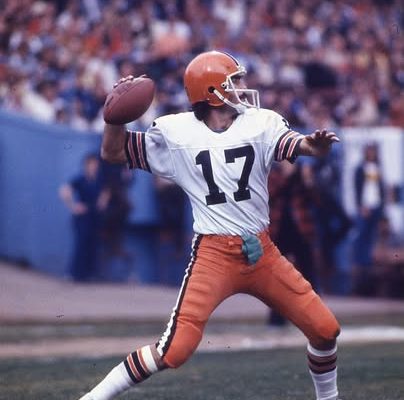Brian Sipe’s story is one that resonates with fans of perseverance, talent, and a little bit of heartbreak—the perfect mix that defines the ethos of professional football and, perhaps more poignantly, the storied yet star-crossed history of the Cleveland Browns. Sipe was more than just a quarterback; he was the face of a franchise during one of its most electrifying eras and the orchestrator of a season that remains etched in NFL lore. That season, of course, was 1980—a year that gave birth to the beloved moniker “The Kardiac Kids,” a team known for its dramatic comebacks and nail-biting finishes, and a year that saw Brian Sipe rise to the top of the football world by winning the NFL’s Most Valuable Player award.
Before we get into the magic of 1980, it’s worth rewinding the clock to understand how Sipe even got to that point. Brian Sipe wasn’t your prototypical NFL superstar in terms of pedigree or initial expectations. Born in San Diego, California, in 1949, Sipe played his college football at San Diego State under the guidance of the legendary Don Coryell. San Diego State wasn’t exactly a football powerhouse in the 1970s, but Coryell’s pass-heavy system allowed Sipe to develop as a true air-raid quarterback long before such systems became en vogue in the NFL. He put up impressive numbers in college, but doubts about his size and arm strength caused many scouts to overlook him when the 1972 NFL Draft rolled around. The Browns selected him in the 13th round, 330th overall—practically an afterthought.
Sipe’s early years in the NFL were largely quiet. He spent time learning, adjusting, and occasionally backing up other quarterbacks. It wasn’t until the mid-1970s that he began to emerge as the Browns’ full-time starter. Cleveland was, at that time, in a bit of a transitional period. They weren’t quite contenders, but they had talent on the roster and were looking for the right quarterback to tie everything together. Sipe showed flashes of promise during the 1976 and 1977 seasons, and by the time 1978 arrived, he had firmly entrenched himself as the team’s top signal-caller.
While he had respectable numbers in the seasons leading up to 1980, nobody could have quite predicted what would happen that year. Under head coach Sam Rutigliano, the Browns took on a daring, pass-first identity. Rutigliano was known for being a cerebral coach, someone who valued intelligence and improvisation. That made Brian Sipe the perfect quarterback for his system. Sipe wasn’t the strongest or the fastest, but he was incredibly smart, had impeccable timing, and knew how to read defenses like a seasoned chess master. He commanded the huddle with quiet confidence, and in 1980, all the elements fell into place.
That season, the Cleveland Browns compiled an 11-5 record, good enough to win the AFC Central Division. But their path to those 11 wins was anything but easy. The team earned the nickname “The Kardiac Kids” because of the heart-stopping nature of their victories. Time and time again, Sipe would lead the Browns to late-game heroics, pulling wins out of the jaws of defeat with fourth-quarter drives that left fans both thrilled and exhausted. It wasn’t just winning that made the Browns special that year—it was how they won. Every game felt like a movie script, complete with unexpected twists, dramatic climaxes, and often, a fairy-tale ending.
Sipe was the engine behind all of it. His statistics that year were staggering for the era: 4,132 passing yards and 30 touchdown passes. In an age where passing games weren’t nearly as prolific as they are today, those numbers stood out dramatically. Sipe’s performance wasn’t just statistically impressive—it was artistically beautiful. He was masterful in his execution, delivering passes with precision, reading blitzes with poise, and maintaining composure in situations where many quarterbacks would have crumbled. He had developed a strong rapport with his receivers, particularly tight end Ozzie Newsome and wideouts like Dave Logan and Reggie Rucker. Each had a role to play, and Sipe knew exactly when to go to whom.
It’s important to contextualize Sipe’s MVP season against the backdrop of the NFL at that time. In 1980, the league was still very much built on running games and stout defenses. Teams like the Pittsburgh Steelers and Dallas Cowboys had set the gold standard for success through their physical dominance. A pass-happy team like the Browns was considered a bit of a gamble, a high-risk proposition that could either explode or implode. Sipe, through his consistent play and calm demeanor, gave Cleveland the ability to navigate those risks effectively. He was the ideal quarterback for a system that challenged convention and redefined how offense could work in the NFL.
The Browns clinched their division, earning a spot in the postseason for the first time since 1972. Cleveland was buzzing. The entire city rallied around the team, and the atmosphere in Municipal Stadium was electric. The fans believed, and for good reason—they had Brian Sipe. Their playoff matchup was against the Oakland Raiders in the AFC Divisional Round. It was a cold January day on the shores of Lake Erie, the kind of setting tailor-made for playoff football. What transpired on that field has become one of the most infamous games in Browns history, remembered not for triumph, but for a singular, devastating moment known as “Red Right 88.”
The Browns had clawed their way to within striking distance of victory. They were down just 14-12 late in the fourth quarter and were in position for a potential game-winning field goal. But rather than play it safe, Rutigliano made a bold call. The play was dubbed “Red Right 88,” a pass play designed to go to the tight end if the coverage allowed. The idea was that if the throw wasn’t there, Sipe would simply throw it away and live to fight another down—or kick the field goal. But when the ball was snapped, Sipe saw something he liked. Perhaps it was a glimpse of daylight, a moment of hesitation in the defense. He went for it. He let the ball fly toward the end zone, aiming for Newsome.
But the Raiders were ready. Defensive back Mike Davis intercepted the pass, and just like that, the game—and the Browns’ dream season—was over. It was a heartbreaking end to a magical year, and Sipe, as the quarterback, bore much of the burden. In hindsight, it was a calculated risk, a play that had worked numerous times during the season. But on that frigid day in Cleveland, it didn’t. The Kardiac Kids were done, not with a bang, but with a silent exhale of disbelief.
Despite that crushing playoff loss, Brian Sipe’s 1980 campaign remains one of the most memorable individual seasons in NFL history. He won the AP NFL MVP award, beating out the likes of Dan Fouts, Terry Bradshaw, and Walter Payton. It was a recognition of not only his stats but his leadership and the intangible qualities that made the Browns such a compelling team that year. Sipe was also named to the Pro Bowl and was widely praised by players, coaches, and analysts alike for his performance.
What makes Sipe’s MVP season even more fascinating is the fact that it didn’t usher in a new dynasty for the Browns. In the years following 1980, the team regressed slightly, never quite capturing the same magic again. Sipe remained a solid quarterback, but the combination of injuries, changing personnel, and internal turmoil took a toll. By 1984, Sipe made the surprising decision to leave the NFL and join the USFL’s New Jersey Generals. It was a bold move, but one that he made in search of both financial security and a new challenge. He played a couple of seasons in the USFL before retiring from professional football.
In many ways, Brian Sipe’s legacy is emblematic of the Cleveland Browns as a franchise. It’s a legacy filled with promise, moments of brilliance, and a lingering sense of “what could have been.” Yet, that shouldn’t overshadow what he accomplished. For that one unforgettable season, Sipe gave Browns fans a reason to believe. He turned a middling team into must-watch television. He made Sundays in Cleveland feel like events. He did it with humility, intelligence, and a quiet toughness that defined his character both on and off the field.
Decades later, Browns fans still talk about the Kardiac Kids with a mix of pride and nostalgia. They remember the late-game drives, the improbable wins, the cold winds of Municipal Stadium whipping through their scarves as they clung to every snap. And at the center of it all, they remember Brian Sipe—No. 17—the man who made them dream again, if only for a season. His name doesn’t often come up in GOAT conversations, and he never won a Super Bowl. But in Cleveland, where football is more religion than sport, Sipe is revered. Not because he was perfect, but because he captured the essence of what it means to be a Brown: gutsy, loyal, and forever hopeful.
Even among modern quarterbacks, Sipe’s numbers from 1980 hold up remarkably well. That season, only a handful of players even approached 4,000 yards passing, and 30 touchdown passes was considered elite. His ability to do that while orchestrating comeback after comeback speaks volumes about his mental toughness. He wasn’t flashy or loud, but his calm in chaos made him the eye of the storm for the Kardiac Kids. He was also a model teammate, always crediting his offensive line, his receivers, his coaching staff—never taking more credit than he felt he deserved.
In retirement, Sipe didn’t chase the spotlight. He went into coaching, returning to his roots in San Diego. He became the quarterbacks coach at his alma mater, San Diego State, and later served as head coach at Santa Fe Christian High School. By all accounts, he brought the same intelligence and integrity to coaching that he had as a player. He mentored young quarterbacks not just in mechanics but in mindset—how to handle pressure, how to read defenses, how to carry yourself like a leader.
Ultimately, Brian Sipe’s career reminds us that football greatness isn’t always measured in rings or headlines. Sometimes it’s measured in moments—those fleeting, heart-stopping bursts of magic that make fans rise from their seats and believe in the impossible. The 1980 Cleveland Browns, led by MVP Brian Sipe, delivered those moments week after week. They made history, even if they fell just short of immortality. And for those who watched it unfold, for those who lived and breathed every snap, that was more than enough.



